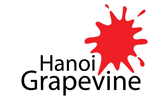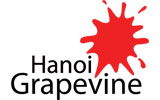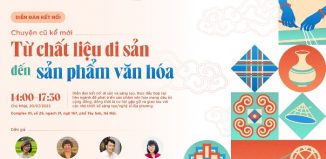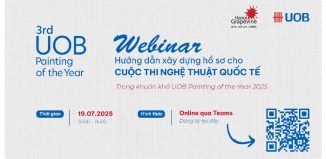Khơi nguồn hệ sinh thái sáng tạo cho Hà Nội: Cộng hưởng nguồn lực cho một tương lai bền vững
Bài viết bởi Chii Nguyễn cho Tuần lễ Khơi nguồn Sáng tạo
Ảnh: Ban tổ chức cung cấp
Vui lòng ghi rõ nguồn khi chia sẻ bài
Không sao chép từng phần hoặc nguyên văn khi chưa có sự cho phép
Mở đầu chuỗi tọa đàm trong Tuần lễ Khơi nguồn sáng tạo, tọa đàm “Khơi nguồn hệ sinh thái sáng tạo ở Hà Nội – Giải pháp và tầm nhìn” đưa ra những vấn đề hết sức cơ bản cho sáng tạo, thảo luận về tiềm năng và những nguồn lực sáng tạo dồi dào, sẵn có của thành phố Hà Nội.

Khách mời của tọa đàm: bà Phạm Thị Lan Anh – Trưởng phòng Quản lý Di sản văn hoá Sở Văn hoá và Thể thao Hà Nội, bà Phạm Thị Thanh Hường – Trưởng Ban Văn hoá Văn phòng UNESCO tại Hà Nội, Tiến sỹ Nguyễn Nhật Quang – Viện trưởng viện Khoa học Công nghệ VINA SA, Thạc sỹ, Kiến trúc sư Nguyễn Duy Thanh – Phó Giám đốc văn phòng 1 + 1 > 2, Giảng viên Đại học Xây dựng Hà Nội và Nhà thiết kế Vũ Thảo – Giám đốc sáng tạo Kilomet 109. Điều phối tọa đàm: Tiến sỹ, Kiến trúc sư Nguyễn Quang.

Bà Phạm Thị Lan Anh bắt đầu tọa đàm bằng tham luận “Hà Nội và tiềm năng xây dựng Thành phố sáng tạo từ nguồn lực văn hoá”. Chúng ta biết rằng Hà Nội là một thành phố giàu di sản và bề dày văn hóa lịch sử. Cơ cấu dân số vàng với hơn 51% dân số trong độ tuổi sáng tạo. Việc phát triển Hà Nội trở thành Thành phố sáng tạo được thành phố hết sức quan tâm. Trong văn kiện Đại hội đại biểu Đảng bộ thành phố Hà Nội lần thứ XVII đã đề ra mục tiêu tổng quát: Đến năm 2025 phát triển nhanh và bền vững Thủ đô theo hướng đô thị xanh, thành phố thông minh, hiện đại có sức cạnh tranh cao trong nước và khu vực, Đến năm 2045, Hà Nội có chất lượng cuộc sống cao; kinh tế, văn hoá, xã hội phát triển toàn diện, bền vững, là thành phố kết nối toàn cầu có sức cạnh tranh quốc tế.
Dưới góc nhìn của người hoạch định chính sách, bà Lan Anh đưa ra 04 giải pháp để Hà Nội thực hiện thành công việc gia nhập Mạng lưới các thành phố sáng tạo: 1) Triển khai đầy đủ các sáng kiến Hà Nội đã cam kết với mạng lưới các thành phố sáng tạo của UNESCO. 2) Tạo sự kết nối giữa truyền thống và hiện đại trong các sản phẩm công nghiệp văn hoá. 3) Phát triển các không gian sáng tạo, hình thành môi trường thúc đẩy sự sáng tạo. 4) Phát triển hạ tầng cơ sở hạ tầng, khoa học công nghệ.

Đồng hành cùng thành phố Hà Nội, bà Phạm Thị Thanh Hường từ UNESCO chia sẻ tầm nhìn và định hướng, đề án xây dựng Hà Nội từ thành phố sáng tạo thành trung tâm sáng tạo của thế giới và trong khu vực. Hà Nội là Thủ đô duy nhất trong khu vực Đông Nam Á có bề dày lịch sử hơn 1000 năm, Thủ đô của một “cường quốc” về văn hoá nhưng lại thiếu “kết nối” giữa các khối nhà nước, tư nhân, các tổ chức quốc tế. Vậy nên, hiện nay Hà Nội đang chậm hơn các thành phố khác trong khu vực trên con tàu sáng tạo. Bà Hường nhấn mạnh sự cần thiết của việc kết nối khối nhà nước, tư nhân và các tổ chức quốc tế để Hà Nội có thể tạo ra giá trị gia tăng từ nguồn vốn di sản khổng lồ và nguồn lực con người sẵn có.
UNESCO đề xuất thành phố Hà Nội xây dựng tầm nhìn dài hạn trong 10 năm, 20 năm, tạo ra vành đai kết nối sáng tạo (Creative Belt) kết nối các tiềm năng của thành phố. Trong đó 3 trụ cột chính UNESCO khuyến nghị và mong muốn đồng hành gồm: 1) Không tách rời quá trình tái thiết đô thị và phát triển đô thị khỏi văn hoá. Truyền cảm hứng văn hoá vào trong quy hoạch đô thị, tái thiết đô thị. 2) Kết nối các khối học viện, cơ sở đào tạo để chúng ta có một tầm nhìn, quy hoạch, tạo ra nguồn lực sáng tạo trên tất cả các lĩnh vực của UNESCO. 3) Xây dựng lộ trình, tầm nhìn tổng quan cho sự năng động về văn hoá, chuỗi sự kiện về văn hoá ở ba cấp: Quốc tế, Quốc gia và Cộng đồng.
Trong khu vực đã có những tấm gương mà Việt Nam có thể học tập mô hình và đưa vào thực tế. Như Singapore đổi mới thiết kế, hỗ trợ hệ sinh thái khởi nghiệp thiết kế để tạo ra bước nhảy vọt. Như Chiang Mai lấy động lực sáng tạo để bảo tồn di sản và làng nghề, kết nối các làng nghề, nghệ thuật thủ công dân gian, thúc đẩy hệ sinh thái kết nối Làng nghề – Nghệ nhân – Nhà thiết kế.

Lần lượt, Tiến sỹ Nguyễn Nhật Quang trình bày tham luận “Công nghệ với thành phố sáng tạo”, cuộc cách mạng công nghiệp lần thứ 4: Cuộc cách mạng thông minh hoá. Chuyển đổi số để thích nghi với tốc độ phát triển của thế giới, khai thác tiềm năng, đổi mới sáng tạo và kết nối. Không gian thực số sẽ tạo ra công cụ hỗ trợ, tạo ra cơ hội nhiều hơn cho văn hoá và nghệ thuật.

THS.KTS Nguyễn Duy Thanh đặt vấn đề: “Không gian sáng tạo và vai trò của giới Kiến trúc sư”. Anh điểm mặt các “điểm sáng” kiến trúc, các không gian sáng tạo thành công trong thời gian qua, như: Zone 9, AGO Hub, 282 workshop, Complex 01, Id Hub, Think Playgrounds và gần đây nhất là Trung tâm tinh hoa làng nghề Việt – Bát Tràng. Thực trạng hiện nay, các điểm sáng này đang hoạt động một cách đơn lẻ với sức phục vụ hạn chế chỉ 1000 – 5000 lượt người/năm trong khi dân số Hà Nội đã lên đến con số 10 triệu người. Vấn đề đặt ra làm sao để kết nối các nguồn lực để tạo ra không gian phục vụ nhiều người hơn nữa. Cộng hưởng để cùng tỏa sáng.

Nhà thiết kế Vũ Thảo, dưới con mắt của một giám đốc sáng tạo và phát triển bền vững, hướng đến việc sáng tạo lấy con người và cộng đồng làm trung tâm, tạo ra các giá trị mới dựa trên và tiếp nối các giá trị truyền thống. Kilomet 109 của chị dựa trên ba yếu tố chính để tạo ra “giá trị nội tại sức mạnh chủ động”. Đó là: Công lực văn hoá xưa, Làng nghề và đột phá, Kiến tạo văn hoá mới. Chị đặc biệt quan tâm đến mối quan hệ giữa thiết kế và môi sinh. Cẩn trọng trong quá trình chế tác để không gây hại đến con người và môi trường sinh sống. Tiếp tục kế thừa và phát triển nhưng không đánh mất văn hoá bản địa.


Phần cuối của buổi tọa đàm, TS.KTS Nguyễn Quang đặt câu hỏi cho từng diễn giả để làm rõ hơn các luận điểm và tính kết nối giữa các bên, như đã đề cập trong toạ đàm: Nhà nước – Tư nhân và các Tổ chức quốc tế. Từ khoá được nhắc đến nhiều nhất trong buổi hỏi đáp này chính là “kết nối” để đưa ra các hành động cụ thể, nhuần nhuyễn từ việc thành phố Hà Nội chủ động tạo ra môi trường thể chế chính sách thúc đẩy hệ sinh thái sáng tạo, đến các xu thế tự nảy sinh từ kết nối trong cộng đồng tạo ra giá trị văn hoá mới. Phát triển song song không gian sáng tạo gắn liền với văn hoá bản địa và gắn liền với các trường đại học, giới hàn lâm. Thúc đẩy kết nối giữa các cá nhân, các tập thể nhỏ lẻ, các đối tượng hoạt động chính và mạnh mẽ nhất trong ngành sáng tạo. Tuy nhiên, tầm nhìn cần hướng tới nhóm các tập đoàn, những gã khổng lồ, để lan tỏa các trị ở diện rộng hơn nữa.




 | Tuần lễ Khơi nguồn Sáng tạo [email protected] Youtube Youtube |

















